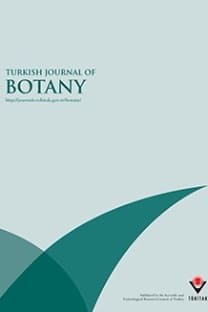A determination of air pollution in Colombo and Kurunegala, Sri Lanka, using energy dispersive X-ray fluorescence spectrometry on Heterodermia speciosa
Key words: Lichens, metal pollution, EDXRF, Heterodermia, air
A determination of air pollution in Colombo and Kurunegala, Sri Lanka, using energy dispersive X-ray fluorescence spectrometry on Heterodermia speciosa
metal pollution, EDXRF, Heterodermia, air, Lichens,
___
- Aslan A, Budak G & Karabulut A (2004). Th e amounts Fe, Ba, Sr, K, Ca and Ti in some lichens growing in Erzurum province (Turkey). J Quant Spectrosc Ra 88: 423-431.
- Aslan A, Budak G, Tıraşoğlu E & Karabulut A (2006). Determination of elements in some lichens growing in Giresun and Ordu province (Turkey) using energy dispersive X-ray fl uorescence spectrometry. J Quant Spectrosc Ra 97: 10-19.
- Hissler C, Stille P, Krein A, Geagea ML, Perrone T, Probst JL & Hoff mann L (2008). Identifying the origins of local atmospheric deposition in the steel industry basin of Luxembourg using the chemical and isotopic composition of the lichen Xanthoria parietina. Sci Total Environ 405: 338-344.
- Kabata-P endias A & Pendias H (1984). Trace Elements in Soils and Plants. Boca Raton: CRC Press Inc.
- Laaksovirta K & Olkkonen H (1979). Eff ect of air pollution on epiphytic lichen vegetation and element contents of a lichen and pine needles at Valkeakoski, S. Finland. Ann Bot Fenn 16: 285-296.
- Markert B (1993). Plants as Biomonitors/Indicators for Heavy Metals in the Terrestrial Environment. Weinheim: VCH Press.
- Markowicz A, Haselberger N, El Hassan HS & Sewando MSA (1992). Accuracy of the emission transmission method applied in XRF analysis of intermediate thickness samples. J Radioanal Nucl Ch 158: 409-415.
- Nayanakantha NMC & Gajameragedara S (2003). A survey of lichens in the Kandy municipal region. Ceylon Journal of Science 31: 35-41.
- Nieboer EA & Kershaw KA (1983). Ecological implications of laboratory toxicity and related photosynthetic studies. Am J Bot 50: 1.
- Nieboer E & Richardson DHS (1981). Lichens as monitors of atmospheric deposition. In: Eisenreich SJ (ed.) Atmospheric Pollutants in Natural Waters, pp. 339-388. Ann Arbor: Ann Arbor Science Publishers.
- Nieboer E, Richardson DHS & Tomassini FD (1978). Mineral uptake and release by lichens: an overview. Bryologist 81: 226-246.
- Öztürk S, Güvenç S & Aslan A (1997). Distribution of epiphytic lichens and sulphur dioxide pollution in the city of Bursa. Turk J Bot 21: 213-215. Puckett KJ (1988). Bryophytes and lichens as monitors of metal deposition. In: Nash TH III & Wirth V (eds.) Lichens, bryopytes and air quality. Bibliotheca Lichenologica 30: 231-267.
- Rhoades FM (1999). A Review of Lichen and Bryophyte Elemental Content Literature with Reference to Pacifi c Northwest Species. Washington: United States Department of Agriculture.
- Richardson DHS, Nieboer E, Lavoie P & Padovan D (1979). Th e role of metal-ion binding in modifying the toxic eff ects of sulphur dioxide on the lichen Umbilicaria muhlenbergii. II. 14C fi xation studies. New Phytol 82: 633-643.
- Rühling Å (1994). Atmospheric Heavy Metal Deposition in Europe - Estimation Based on Moss Analysis. Copenhagen: Nordic Council of Ministers.
- Seneviratne MCS, Mahawatte P, Fernando RKS, Hewamanna R & Sumithrarachchi C (1999). A study of air particulate pollution in Colombo using XRF. Biol Trace Elem Res 71-72: 189-194.
- Sloof JE & Wolterbeek BT (1992). Lichens as biomonitors for radiocaesium following the Chernobyl accident. J Environ Radioactiv 16: 229-242.
- Sommerfeldt M & John V (2001). Evaluation of a method for the reassessment of air quality by lichen mapping in the city of İzmir, Turkey. Turk J Bot 25: 45-55.
- Suleyman H, Odabasoglu F, Aslan A, Çakir A, Karagoz Y, Gocer F, Halici M & Bayir Y (2002). Anti-infl ammatory and antiulcerogenic eff ects of aqueous extract of Lobaria pulmonaria (L.) Hoff m. Phytomedicine 10: 552-557.
- Temina M, Andreev MP, Barinova S & Nevo E (2009). Th e diversity and ecology of epiphytic lichens in “Evolution Canyon” II, Lower Nahal Keziv, Upper Western Galilee, Israel. Turk J Bot 33: 263-275.
- Vezda A, Brunnbauer W & Breuss O (1997). Flechten aus Sri Lanka. Annalen des Naturhistorisches Museum Wien Botanische 99: 737-742.
- Vitt DH, Marsh JE & Bovey RB (1988). Mosses, Lichens, and Ferns of Northwest North America, Alberta: Lone Pine Publishing.
- Wetmore CM (1984). Analytical role of lichens. International Lichenological Newsletter 17: 1-2.
- ISSN: 1300-008X
- Yayın Aralığı: 6
- Yayıncı: TÜBİTAK
Patikiri Arachchilage Don Hasantha Nayan GUNATHILAKA
A new species of Minuartia (Caryophyllaceae) from northwestern Anatolia, Turkey
Murat KOÇ, Ahmet AKSOY, Ergin HAMZAOĞLU
Moinuddin AHMED, Syed Shahid SHAUKAT, Muhammad Faheem SIDDIQUI
Ahmet Emin ATİK, Gönensin Ozan BOZDAĞ, Ersin AKINCI, Alaattin KAYA, Ahmet KOÇ, Talat YALÇIN
Strategies for conserving forest genetic resources in the face of climate change
John Bradley ST.CLAIR, Glenn Thomas HOWE
A synopsis of the genus Pulsatilla (Ranunculaceae) in Turkey
Ahmet Emre YAPRAK, Selçuk Tuğrul KÖRÜKLÜ, A. Osman KETENOĞLU
Salvia brachyantha subsp. tankutiana (Lamiaceae), a new subspecies from Central Anatolia
Safi BAGHERPOUR, Ferhat CELEP, Ahmet KAHRAMAN, Musa DOĞAN
